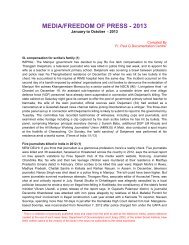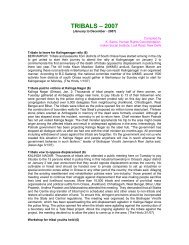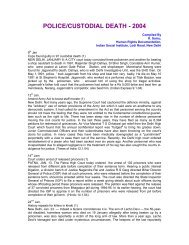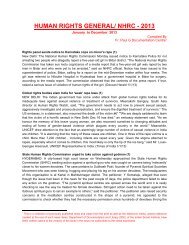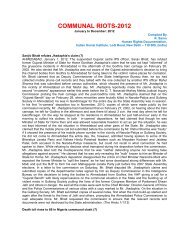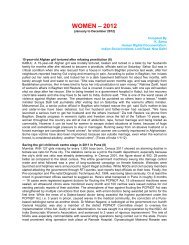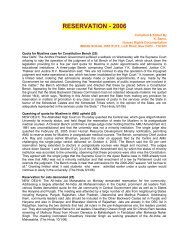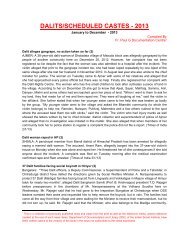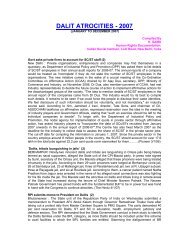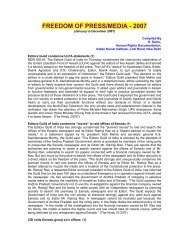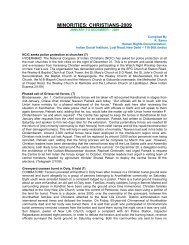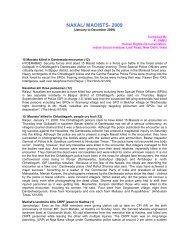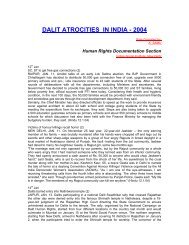land acquisition/sez & displacement â 2011 - Indian Social Institute
land acquisition/sez & displacement â 2011 - Indian Social Institute
land acquisition/sez & displacement â 2011 - Indian Social Institute
You also want an ePaper? Increase the reach of your titles
YUMPU automatically turns print PDFs into web optimized ePapers that Google loves.
The 2007 Bills had sought to reduce the extent of <strong>land</strong> <strong>acquisition</strong> by the state for a company to 30 percent , if the company purchases 70 per cent of the <strong>land</strong> needed by negotiation. The present Bill doesaway with the 70:30 formula, but provides for ‘partial' <strong>acquisition</strong> by the state for a company if a companyso requests. Presumably ‘partial' <strong>acquisition</strong> could go up to near-full <strong>acquisition</strong> by the state. This seemsa retrograde step. (v) Private purchase: As for private negotiation, the Minister himself refers in hisForeword to the “asymmetry of power (and information) between those wanting to acquire the <strong>land</strong> andthose whose <strong>land</strong>s are being acquired”, but the Bill provides no mechanism to reduce that asymmetry. Itdoubtless extends the R&R provisions to private negotiated purchases of <strong>land</strong> but provides no safeguardagainst unfair negotiation. (Even the extension of the R&R provisions to negotiated purchases — thelegality of which may be challenged — applies only where a company buys 100 acres or more, and thatthreshold can be easily side-stepped in ways that need not be spelt out here.) One wishes that theMinister had strengthened the hands of the weaker party in the negotiation by providing — this is merelyan illustration — that the compensation that the <strong>land</strong>-owners would have got under this Bill if the <strong>land</strong> hadbeen acquired by the government (to be determined by the collector) would be the floor below which theprice negotiated by the company with the <strong>land</strong>-owners shall not fall. (vi) Change of <strong>land</strong> use: Thatsafeguard might ensure a fair price, but there is also the question of transfer of agricultural <strong>land</strong> to nonagriculturaluse and the implications for food security. One possibility might be to say that all <strong>acquisition</strong> of<strong>land</strong>, including <strong>acquisition</strong>s for companies, must be only by the state; but that does not seem desirableand, in any case, it is not really an answer to the problem of <strong>land</strong>-transfer away from agriculture. Anotherpossibility is that private purchases of agricultural <strong>land</strong> should be subject to state regulation from the pointof view of <strong>land</strong>-use. That might be open to the objection of undue interference with a <strong>land</strong>owner's right tosell his <strong>land</strong>. On the whole, the answer to the question of minimising transfers of agricultural <strong>land</strong> to nonagriculturaluse might lie in policies supportive of agriculture rather than in control or regulation over <strong>land</strong>transactions. (vii) Definition of ‘public purpose': An issue that has persistently figured in the debate duringthe last decade or two is the need to narrow the definition of ‘public purpose' and limit it to a few strictlygovernmental purposes (schools, dispensaries, etc). The present Bill moves in exactly the oppositedirection. It defines ‘public purpose' very broadly and leaves it to the bureaucracy to decide each case. Isit right to assume that any industry ipso facto serves a public purpose warranting the alienation ofagricultural <strong>land</strong>? For instance, in the Singur episode <strong>land</strong> <strong>acquisition</strong> was for ‘industry', i.e., Tatas' smallcar factory; was that ‘public purpose'? It can be so declared under the present Bill. Again, ‘infrastructure'includes ‘tourism', which would permit the <strong>acquisition</strong> of <strong>land</strong> for building hotels. It seems desirable todefine ‘public purpose' somewhat more stringently. (viii) Coverage of ‘project-affected persons': The Billrefers to loss of primary livelihoods but links it to the <strong>acquisition</strong> of <strong>land</strong>. The term ‘livelihoods' is illustratedby a reference to the gathering of forest produce, hunting, fishing, etc; there is no reference to sellers ofgoods and services to the people in the project area, who will lose their livelihoods when the peoplewhom they serve move away to resettlement areas. It is not clear whether they will be regarded asproject-affected persons. (ix) <strong>Social</strong> Impact Assessment: On <strong>Social</strong> Impact Assessment the present Bill isan improvement on the 2007 Bill, but the idea of SIA still falls short: it does not cover the disappearanceof a whole way of life; the dispersal of close-knit communities; the loss of a centuries-old relationship withnature; the loss of roots; and so on. It is good that the SIA will be reviewed by an independent multidisciplinaryexpert body, but it should first be prepared by a similar body. The Bill leaves the SIA to beprepared by the “appropriate government.” (x) Rehabilitation package: The rehabilitation package isdistinctly inferior to the packages already established in certain projects. The principle of ‘<strong>land</strong> for <strong>land</strong>'has been abandoned. It figures only in the case of irrigation projects, and there the Bill envisages oneacre per family instead of two acres as in the Sardar Sarovar Project. There are two points here. First, it isnot clear why the Bill specifies irrigation projects; hydroelectric projects and flood control also have thesame impacts as irrigation projects, and in any case many projects are ‘multi-purpose' projects. Secondly,compensation and rehabilitation should have reference not to the nature of the project but to the nature ofthe impact. Whatever be the project, if an agricultural community is uprooted from its <strong>land</strong> andhomestead, it has to be enabled to practise agriculture elsewhere, and not expected to becomecarpenters or weavers or traders. (xi) Other matters: A number of officials and institutions are specified inthe Bill, such as the Collector, Administrator of R&R, Commissioner of R&R, etc., but it is only in the R&RCommittee that there is a significant non-official presence. The National Monitoring Committee is not‘participatory'; apart from officials, it includes only a few experts. As indicated earlier, the idea of aNational Rehabilitation Commission has been abandoned. Incidentally, it is not clear why <strong>displacement</strong> by



